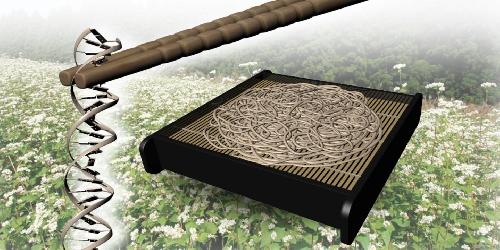Japan -- Gluten-free noodles and other buckwheat-based foods might get tastier, prettier, and non-allergenic with hints from new genomics research. Yasuo Yasui of Kyoto University and colleagues have sequenced the full buckwheat genome for the first time, identifying genes which could be modified for improved cultivation capabilities and taste appeal.
Buckwheat is a central ingredient in soba noodles -- a traditional Japanese favorite -- and is also used to make other noodles from China and Korea. In Europe, buckwheat is used in Italian pizzoccheri, French gallettes, and Slovenian struklji, and in other regions of the world it appears in pancakes and other foods.
Yasui explains that buckwheat has major faults as a crop despite a long history of cultivation; buckwheat plants prevent themselves from self-fertilization, and the grain contains allergens that elicit strong reactions in some people.
 Kyoto University researchers and colleagues have sequenced the full buckwheat genome for the first time, identifying genes which could be modified for improved cultivation capabilities and taste appeal. Credit: Kyoto University
Kyoto University researchers and colleagues have sequenced the full buckwheat genome for the first time, identifying genes which could be modified for improved cultivation capabilities and taste appeal. Credit: Kyoto University
"Genome data is essential to make crops better suited for our needs, but until now data on the knotweed family of plants, including buckwheat, were not available," says Yasui. "In our study we sequenced the entire genome and created a Buckwheat Genome DataBase, which is now available publicly from the Kazusa DNA Research Institute."
In the study, published in DNA Research, the team found genes related to "mochi-ness", which refer to the soft, chewy texture of foods like marshmallows or fresh bagels.
"Scientists have so far succeed in getting the distinctive 'mochi' texture out of wheat, but that hadn't been accomplished yet with buckwheat," says Yasui. "Since we've found the genes that could give buckwheat this texture, I think we can hope to see foods -- including soba noodles and doughy European foods -- with radical new sensations appearing on the market in the near future."
The team also identified genes that synthesize 'proanthocyanidins', which make buckwheat turn darker in color when oxidized. Modifying these genes could prevent buckwheat from brewing this compound, making the flour more visually appealing.
Better yet, Yasui says the results of the genome sequencing might bring happy outcomes not only to buckwheat-food lovers but also to those who were allergic to them.
"Buckwheat flour can replace wheat flour in a gluten-free diet. One of our next goals is to make buckwheat less allergenic so that buckwheat-based foods become an option for more people."
source: Kyoto University